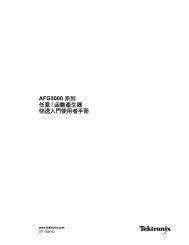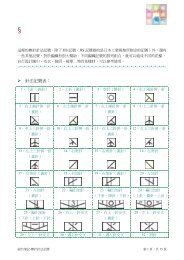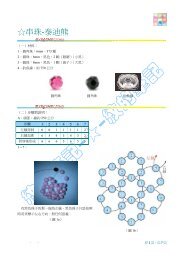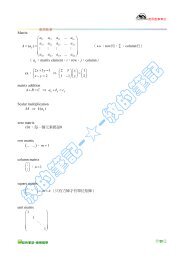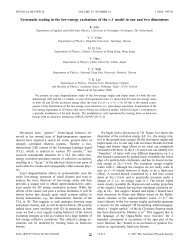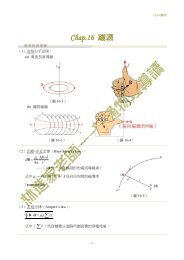Chapter 22 Materials Selection and Design Considerations
Chapter 22 Materials Selection and Design Considerations
Chapter 22 Materials Selection and Design Considerations
You also want an ePaper? Increase the reach of your titles
YUMPU automatically turns print PDFs into web optimized ePapers that Google loves.
W130 • <strong>Chapter</strong> <strong>22</strong> / <strong>Materials</strong> <strong>Selection</strong> <strong>and</strong> <strong>Design</strong> <strong>Considerations</strong><br />
REFERENCES<br />
General<br />
<strong>and</strong> exposure rate. Equations were provided that allow computation of these<br />
parameters, <strong>and</strong> values were determined for seven common protective glove materials.<br />
Only two materials {multilayered [poly(vinyl alcohol)/polyethylene] <strong>and</strong> Viton<br />
rubber} were deemed satisfactory for this application.<br />
<strong>Materials</strong> for Integrated Circuit Packages<br />
<strong>Materials</strong> utilized for the integrated circuit package incorporating the leadframe<br />
design were the topics of the final case study. An IC chip is bonded to the leadframe<br />
plate using either a eutectic solder or an epoxy resin. The leadframe material<br />
must be both electrically <strong>and</strong> thermally conductive, <strong>and</strong>, ideally, have a<br />
coefficient of thermal expansion that matches the IC chip material (i.e., silicon<br />
or gallium arsenide); copper alloys are commonly used leadframe materials. Very<br />
thin wires (preferably of gold, but often of copper or aluminum) are used to make<br />
electrical connections from the microscopic IC chip contact pads to the leadframe.<br />
Ultrasonic microjoining welding/brazing techniques are used where each<br />
connection joint may be in the form of either a ball or wedge. The final step is<br />
package encapsulation, wherein this leadframe–wire–chip assembly is encased in<br />
a protective enclosure. Ceramic glasses <strong>and</strong> polymeric resins are the most common<br />
encapsulation materials. Resins are less expensive than glasses <strong>and</strong> require<br />
lower encapsulation temperatures; however, glasses normally offer a higher level<br />
of protection.<br />
Ashby, M. F., CES4 EduPack—Cambridge Engineering<br />
Selector, Granta <strong>Design</strong> Ltd.,Cambridge,<br />
UK, http://www.grantadesign.com.<br />
Ashby, M. F., <strong>Materials</strong> <strong>Selection</strong> in Mechanical <strong>Design</strong>,<br />
2nd edition, Butterworth-Heinemann,<br />
Woburn, UK, 2002.<br />
Budinski, K. G. <strong>and</strong> M. K. Budinski, Engineering<br />
<strong>Materials</strong>: Properties <strong>and</strong> <strong>Selection</strong>, 8th edition,<br />
Pearson Prentice Hall, Upper Saddle River, NJ,<br />
2005.<br />
Dieter, G. E., Engineering <strong>Design</strong>, A <strong>Materials</strong> <strong>and</strong><br />
Processing Approach, 3rd edition, McGraw-<br />
Hill, New York, 1999.<br />
Mangonon, P. L., The Principles of <strong>Materials</strong> <strong>Selection</strong><br />
for Engineering <strong>Design</strong>, Pearson Prentice<br />
Hall, Upper Saddle River, NJ, 1999.<br />
Optimization of Strength<br />
Ashby, M. F. <strong>and</strong> D. R. H. Jones, Engineering <strong>Materials</strong><br />
1, An Introduction to Their Properties<br />
<strong>and</strong> Applications, 3rd edition, Butterworth-<br />
Heinemann, Woburn, UK, 2005.<br />
Spring <strong>Design</strong><br />
Juvinall, R. C. <strong>and</strong> K. M Marshek, Fundamentals<br />
of Machine Component <strong>Design</strong>, 4th edition,<br />
<strong>Chapter</strong> 12, John Wiley & Sons, Hoboken, NJ,<br />
2005.<br />
Shigley, J., C. Mischke, <strong>and</strong> R. Budynas, Mechanical<br />
Engineering <strong>Design</strong>, 7th edition, <strong>Chapter</strong> 10,<br />
McGraw-Hill Companies, New York, 2004.<br />
Artificial Total Hip Replacement<br />
Black, J. <strong>and</strong> G. Hastings (Editors), H<strong>and</strong>book<br />
of Biomaterial Properties, Chapman & Hall,<br />
London, 1998.<br />
Davis, J. R., H<strong>and</strong>book of <strong>Materials</strong> for Medical<br />
Devices, ASM International, <strong>Materials</strong> Park,<br />
OH, 2003.<br />
Chemical Protective Clothing<br />
Forsberg, K. <strong>and</strong> S. Z. Mansdorf, Quick <strong>Selection</strong><br />
Guide to Chemical Protective Clothing, 4th<br />
edition, John Wiley & Sons, Hoboken, NJ,<br />
2003.<br />
<strong>Materials</strong> for Integrated Circuit Packages<br />
Electronic <strong>Materials</strong> H<strong>and</strong>book, Vol. I, Packaging,<br />
ASM International, <strong>Materials</strong> Park, OH, 1989.<br />
Grovenor, C. R. M., Microelectronic <strong>Materials</strong>, Institute<br />
of Physics Publishing, Bristol, 1989.<br />
Reprinted by Adam Hilger, Ltd., Bristol, UK.



